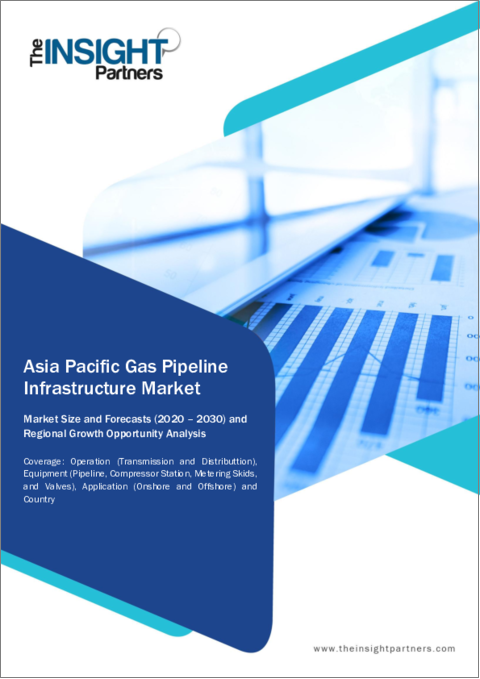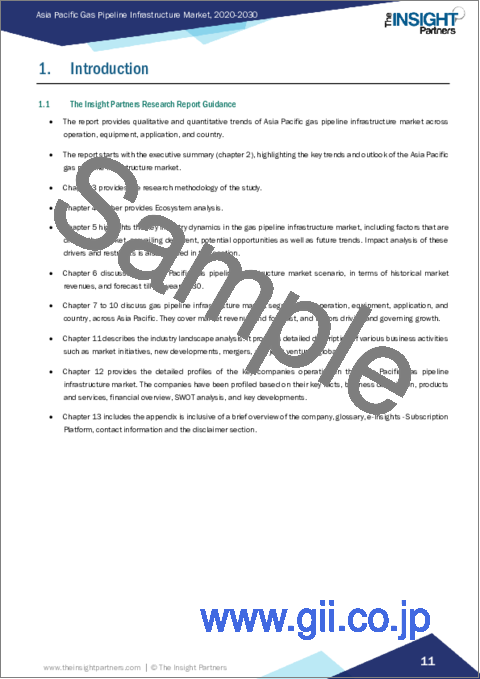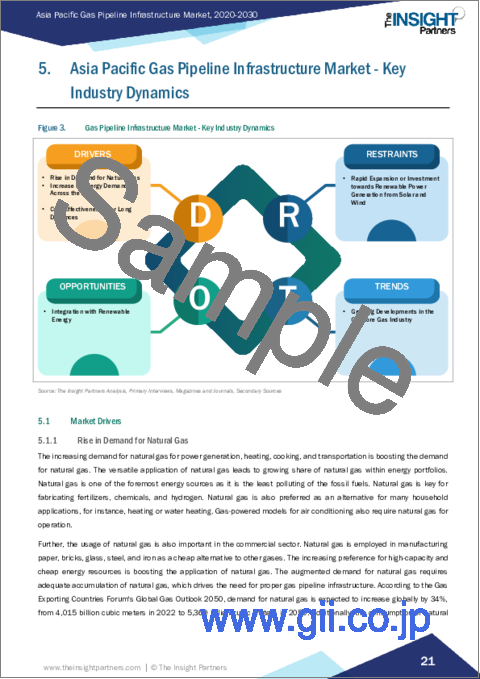|
|
市場調査レポート
商品コード
1562421
アジア太平洋地域のガスパイプラインインフラ:2030年市場予測- 地域別分析- 事業別、設備別、用途別Asia Pacific Gas Pipeline Infrastructure Market Forecast to 2030 - Regional Analysis - by Operation (Transmission and Distribution), Equipment (Pipeline, Compressor Station, Metering Skids, and Others), and Application (Onshore and Offshore) |
||||||
|
|||||||
| アジア太平洋地域のガスパイプラインインフラ:2030年市場予測- 地域別分析- 事業別、設備別、用途別 |
|
出版日: 2024年07月04日
発行: The Insight Partners
ページ情報: 英文 74 Pages
納期: 即納可能
|
- 全表示
- 概要
- 図表
- 目次
アジア太平洋のガスパイプラインインフラ市場は、2022年の6,309億米ドルから2030年には1兆749億米ドルに成長すると予想されています。2022~2030年のCAGRは6.9%を記録すると推定されます。
エネルギー需要の増加がアジア太平洋のガスパイプラインインフラ市場を後押し
人口増加や都市化の進展は、世界のエネルギー消費を押し上げるいくつかの要因です。例えば、インドは所得の増加と生活水準の向上により、世界第3位のエネルギー消費国となっています。中国、米国に次いで、インドのエネルギー消費量は2,000年以降倍増しているが、需要の80%は依然として石油、石炭、固形バイオマスで賄われています。インドのエネルギー・ポートフォリオに占める天然ガスの割合は6%です。しかし、今後20年間で、インドのガス消費量はエネルギー・ポートフォリオに占める割合が2倍以上になると予測されています。天然ガスは発電に利用できる可能性があり、これが需要を押し上げています。さらに、ロシア・ウクライナ戦争に起因する欧州におけるエネルギー不安の増大により、いくつかの国の政府も天然ガスの利用を後押ししています。このように、エネルギー需要の増加がガスパイプラインインフラ市場の成長を促進しています。
アジア太平洋のガスパイプラインインフラ市場概要
天然ガス発電は、化石燃料の中で最も排出量が少なく、環境への影響も少ないLNGが牽引しています。よりクリーンなエネルギー源として、LNGはアジア太平洋の数カ国のエネルギー需要を満たすと推定されています。中国、日本、インドは、アジア太平洋のガスパイプラインインフラ市場で事業を展開している主要国の一部です。天然ガスの生産と流通を支援するための政府の規則、規制、改革は、アジア太平洋におけるガスパイプラインインフラ整備の主要促進要因です。ガスの供給とアクセスを改善するためのガスパイプラインの拡大に向けた政府の融資と支援も、アジア太平洋のガスパイプラインインフラ市場に影響を与えています。アジア太平洋の様々な商業・産業部門における天然ガスの利用拡大が、ガスパイプラインインフラストラクチャ市場の成長を間もなく促進すると考えられます。カーボンニュートラル社会の実現に向けた関心の高まりが、さまざまな商業・産業セグメントでの天然ガスの応用と需要を後押ししています。さらに、発電用の天然ガス需要の高まりも、ガスパイプラインインフラストラクチャ市場の大きな後押しとなっています。石油資源開発(JAPEX)は、日本におけるガスインフラストラクチャーの主要企業の1つであり、主に国内ガス供給システムに重点を置き、最大800km以上に及ぶ高圧ガスパイプラインのネットワークを確立しています。このネットワークは、国内の石油・ガス基地とLNG基地の間を橋渡しし、パイプラインを通じて顧客に天然ガスを供給します。新潟・仙台ガスパイプライン、相馬・岩沼ガスパイプライン、白石・郡山ガスパイプラインは、日本の主要ガスパイプライン網の一部です。日本のガス部門は、いくつかの強力な協力関係を確認しており、今後数年間、生産事業を強化することが期待されています。JX日鉱日石開発は現在、石油・ガスセグメントでの地位を強化するため、日本海洋掘削株式会社(JDC)の買収を進めています。日本企業はまた、各国で海上ガス事業の強力な契約を獲得しています。JDCは2023年2月、タイ沖のブアルアン油田でHakuryu-11ジャックアップ・リグの掘削支援を行う契約を獲得しました。こうした発展が、日本のガスパイプラインインフラ市場の成長を後押ししています。
アジア太平洋のガスパイプラインインフラ市場の収益と2030年までの予測(10億米ドル)
アジア太平洋のガスパイプラインインフラ市場のセグメンテーション
アジア太平洋のガスパイプラインインフラ市場は、事業、設備、用途、国に区分されます。
事業に基づき、アジア太平洋のガスパイプラインインフラ市場はトランスミッションとディストリビューションに二分されます。2022年のアジア太平洋のガスパイプラインインフラ市場では、配給セグメントが大きなシェアを占めています。
設備面では、アジア太平洋のガスパイプラインインフラ市場はパイプライン、コンプレッサーステーション、計量スキッド、バルブに分類されます。パイプラインセグメントは2022年にアジア太平洋のガスパイプラインインフラ市場で最大のシェアを占めました。
用途別では、アジア太平洋のガスパイプラインインフラ市場は陸上と海洋に二分されます。2022年のアジア太平洋のガスパイプラインインフラ市場では、陸上セグメントが大きなシェアを占めています。
国別では、アジア太平洋のガスパイプラインインフラ市場は、中国、日本、インド、インドネシア、オーストラリア、その他のアジア太平洋に区分されます。2022年のアジア太平洋のガスパイプラインインフラ市場は日本が独占しています。
Berkshire Hathaway Inc、Pipeline Infrastructure Ltd、Saipem SpA、China Petroleum &Chemical Corpは、アジア太平洋のガスパイプラインインフラ市場で事業を展開する主要企業です。
目次
第1章 イントロダクション
第2章 エグゼクティブサマリー
- 主要洞察
- 市場の魅力
第3章 調査手法
- 調査範囲
- 2次調査
- 1次調査
第4章 ガスパイプラインインフラ市場情勢
- イントロダクション
- エコシステム分析
- 生産
- トランスミッション
- 配給
- エンドユーザー
第5章 アジア太平洋のガスパイプラインインフラ市場:主要産業力学
- 市場促進要因
- 天然ガス需要の増加
- エネルギー需要の増加
- 長距離における費用対効果
- 市場抑制要因
- 太陽光や風力による再生可能エネルギー発電への急速な拡大や投資
- 市場機会
- 再生可能エネルギーとの統合
- 市場動向
- オフショアガス産業の発展
- 促進要因と阻害要因の影響
第6章 ガスパイプラインインフラ市場:アジア太平洋市場分析
- ガスパイプラインインフラストラクチャ市場の収益(2020~2030年)
- ガスパイプラインインフラ市場の予測・分析
第7章 アジア太平洋のガスパイプラインインフラストラクチャー市場分析-事業
- イントロダクション
- ガスパイプラインインフラ市場:事業別(2022年、2030年)
- 送電
- 送電市場:収益と2030年までの予測
- 配電
- 配電市場、収益と2030年までの予測
第8章 アジア太平洋のガスパイプラインインフラ市場分析-設備
- イントロダクション
- ガスパイプラインインフラ市場:設備別(2022年、2030年)
- パイプライン
- パイプライン市場、収益と2030年までの予測
- バルブ
- バルブ概要
- バルブ市場、収益と2030年までの予測
- コンプレッサーステーション
- コンプレッサーステーション概要
- コンプレッサーステーション市場、収益と2030年までの予測
- 計量スキッド
- 計量スキッド市場、収益と2030年までの予測
第9章 アジア太平洋のガスパイプラインインフラ市場分析:用途
- イントロダクション
- ガスパイプラインインフラ市場:用途別(2022年、2030年)
- オンショア
- オンショア
- オンショア市場の収益と2030年までの予測
- オフショア
- オフショア概要
- オフショア市場、収益と2030年までの予測
第10章 アジア太平洋のガスパイプラインインフラ市場:国別分析
- アジア太平洋市場概要
- オーストラリア
- 中国
- 日本
- インド
- インドネシア
- その他のアジア太平洋
第11章 業界情勢
- イントロダクション
- 市場イニシアティブ
- 合併と買収
第12章 企業企業プロファイル
- Berkshire Hathaway Inc
- Pipeline Infrastructure Ltd
- Saipem SpA
- China Petroleum & Chemical Corp
第13章 付録
List Of Tables
- Table 1. Gas Pipeline Infrastructure Market Segmentation
- Table 2. Gas Pipeline Infrastructure Market Revenue and Forecasts to 2030 (US$ Billion)
- Table 3. Gas Pipeline Infrastructure Market Revenue and Forecasts to 2030 (US$ Billion) - Operation
- Table 4. Gas Pipeline Infrastructure Market Revenue and Forecasts to 2030 (US$ Billion) - Equipment
- Table 5. Gas Pipeline Infrastructure Market Revenue and Forecasts to 2030 (US$ Billion) - Application
- Table 6. Asia Pacific Gas Pipeline Infrastructure Market Revenue and Forecasts to 2030 (US$ Bn) - By Country
- Table 7. Australia Gas Pipeline Infrastructure Market Revenue and Forecasts to 2030 (US$ Bn) - By Operation
- Table 8. Australia Gas Pipeline Infrastructure Market Revenue and Forecasts to 2030 (US$ Bn) - By Equipment
- Table 9. Australia Gas Pipeline Infrastructure Market Revenue and Forecasts to 2030 (US$ Bn) - By Application
- Table 10. China Gas Pipeline Infrastructure Market Revenue and Forecasts to 2030 (US$ Bn) - By Operation
- Table 11. China Gas Pipeline Infrastructure Market Revenue and Forecasts to 2030 (US$ Bn) - By Equipment
- Table 12. China Gas Pipeline Infrastructure Market Revenue and Forecasts to 2030 (US$ Bn) - By Application
- Table 13. Japan Gas Pipeline Infrastructure Market Revenue and Forecasts to 2030 (US$ Bn) - By Operation
- Table 14. Japan Gas Pipeline Infrastructure Market Revenue and Forecasts to 2030 (US$ Bn) - By Equipment
- Table 15. Japan Gas Pipeline Infrastructure Market Revenue and Forecasts to 2030 (US$ Bn) - By Application
- Table 16. India Gas Pipeline Infrastructure Market Revenue and Forecasts to 2030 (US$ Bn) - By Operation
- Table 17. India Gas Pipeline Infrastructure Market Revenue and Forecasts to 2030 (US$ Bn) - By Equipment
- Table 18. India Gas Pipeline Infrastructure Market Revenue and Forecasts to 2030 (US$ Bn) - By Application
- Table 19. Indonesia Gas Pipeline Infrastructure Market Revenue and Forecasts to 2030 (US$ Bn) - By Operation
- Table 20. Indonesia Gas Pipeline Infrastructure Market Revenue and Forecasts to 2030 (US$ Bn) - By Equipment
- Table 21. Indonesia Gas Pipeline Infrastructure Market Revenue and Forecasts to 2030 (US$ Bn) - By Application
- Table 22. Rest of Asia Pacific Gas Pipeline Infrastructure Market Revenue and Forecasts to 2030 (US$ Bn) - By Operation
- Table 23. Rest of Asia Pacific Gas Pipeline Infrastructure Market Revenue and Forecasts to 2030 (US$ Bn) - By Equipment
- Table 24. Rest of Asia Pacific Gas Pipeline Infrastructure Market Revenue and Forecasts to 2030 (US$ Bn) - By Application
- Table 25. List of Abbreviation
List Of Figures
- Figure 1. Gas Pipeline Infrastructure Market Segmentation, By Country
- Figure 2. Ecosystem: Gas pipeline infrastructure market
- Figure 3. Gas Pipeline Infrastructure Market - Key Industry Dynamics
- Figure 4. Impact Analysis of Drivers and Restraints
- Figure 5. Gas Pipeline Infrastructure Market Revenue (US$ Billion), 2020 - 2030
- Figure 6. Gas Pipeline Infrastructure Market Share (%) - Operation, 2022 and 2030
- Figure 7. Transmission Market Revenue and Forecasts to 2030 (US$ Billion)
- Figure 8. Distribution Market Revenue and Forecasts to 2030 (US$ Billion)
- Figure 9. Gas Pipeline Infrastructure Market Share (%) - Equipment, 2022 and 2030
- Figure 10. Pipeline Market Revenue and Forecasts to 2030 (US$ Billion)
- Figure 11. Valves Market Revenue and Forecasts to 2030 (US$ Billion)
- Figure 12. Compressor station Market Revenue and Forecasts to 2030 (US$ Billion)
- Figure 13. Metering skids Market Revenue and Forecasts to 2030 (US$ Billion)
- Figure 14. Gas Pipeline Infrastructure Market Share (%) - Application, 2022 and 2030
- Figure 15. Onshore Market Revenue and Forecasts to 2030 (US$ Billion)
- Figure 16. Offshore Market Revenue and Forecasts to 2030 (US$ Billion)
- Figure 17. Asia Pacific Gas Pipeline Infrastructure Market, By Key Country - Revenue 2022 (US$ Bn)
- Figure 18. Asia Pacific Gas Pipeline Infrastructure Market Breakdown by Country (2022 and 2030)
- Figure 19. Australia Gas Pipeline Infrastructure Market Revenue and Forecasts to 2030 (US$ Bn)
- Figure 20. China Gas Pipeline Infrastructure Market Revenue and Forecasts to 2030 (US$ Bn)
- Figure 21. Japan Gas Pipeline Infrastructure Market Revenue and Forecasts to 2030 (US$ Bn)
- Figure 22. India Gas Pipeline Infrastructure Market Revenue and Forecasts to 2030 (US$ Bn)
- Figure 23. Indonesia Gas Pipeline Infrastructure Market Revenue and Forecasts to 2030 (US$ Bn)
- Figure 24. Rest of Asia Pacific Gas Pipeline Infrastructure Market Revenue and Forecasts to 2030 (US$ Bn)
The Asia Pacific gas pipeline infrastructure market is expected to grow from US$ 630.90 billion in 2022 to US$ 1,074.90 billion by 2030. It is estimated to record a CAGR of 6.9% from 2022 to 2030.
Increase in Energy Demand Boosts Asia Pacific Gas Pipeline Infrastructure Market
The rising population and growing urbanization are a few factors boosting the consumption of energy worldwide. For instance, India is the third largest energy-consuming country worldwide, owing to growing incomes and improved living standards; after China and the US, India's energy consumption has doubled since 2000, with 80% of demand still met by oil, coal, and solid biomass. Natural gas accounts for 6% of India's energy portfolio. However, over the next 20 years, India's gas consumption is projected to more than double its share of the energy portfolio, owing to its high demand in manufacturing, commercial, and industrial sectors. Natural gas has the potential application in electricity generation, which boosts its demand. Furthermore, due to the increasing energy uncertainties in Europe owing to the Russia-Ukraine war, governments of several countries are also boosting the application of natural gas. Thus, the increase in energy demand fuels the growth of the gas pipeline infrastructure market.
Asia Pacific Gas Pipeline Infrastructure Market Overview
Natural gas power generation is driven by LNG, which has the least emission and thus has the lowest environmental impact among all fossil fuels. As a cleaner energy source, it is presumed to serve energy demand in several countries of Asia Pacific. China, Japan, and India are a few of the major countries operating in the gas pipeline infrastructure market in Asia Pacific. Government rules, regulations, and reforms to support the production and distribution of natural gas are major driving factors for the development of gas pipeline infrastructure in Asia Pacific. Government financing and support toward expanding gas pipelines for improved gas supply and access is also influencing the market for gas pipeline infrastructure across Asia Pacific. The growing application of natural gas in different commercial and industrial sectors in Asia Pacific is likely to fuel the gas pipeline infrastructure market growth soon. The growing focus on developing a carbon-neutral society is boosting the application and demand for natural gas in various commercial and industrial sectors. In addition, the rising demand for natural gas for electricity generation is also acting as a major booster for the gas pipeline infrastructure market. Japan Petroleum Exploration Company Limited (JAPEX), one of the major companies in gas infrastructure in Japan, has established a network of high-pressure gas pipelines, expanding up to 800 km or more, which primarily focuses on the domestic gas supply system. The network bridges the gap between domestic oil & gas sites and LNG terminals to provide natural gas to clients through the pipelines. Niigata-Sendai Gas Pipeline, Soma-Iwanuma Gas Pipeline, and Shiroishi-Koriyama Gas Pipeline are a few of the major gas pipeline networks in Japan. The Japanese gas sector has been witnessing a few strong collaborations, which are expected to fortify its production operations in the coming years. JX Nippon Oil & Gas Exploration Corporation is currently in the process of acquiring the Japan Drilling Co. (JDC) to strengthen its position in the oil & gas sector. Japanese companies have also procured strong contracts for offshore gas operations in different countries. In February 2023, JDC won a contract to provide drilling support to the Hakuryu-11 jack-up rig at the Bualuang field offshore Thailand. Such developments are fueling the growth of the gas pipeline infrastructure market in Japan.
Asia Pacific Gas Pipeline Infrastructure Market Revenue and Forecast to 2030 (US$ Billion)
Asia Pacific Gas Pipeline Infrastructure Market Segmentation
The Asia Pacific gas pipeline infrastructure market is segmented into operation, equipment, application, and country.
Based on operation, the Asia Pacific gas pipeline infrastructure market is bifurcated into transmission and distribution. The distribution segment held a larger share of Asia Pacific gas pipeline infrastructure market in 2022.
In terms of equipment, the Asia Pacific gas pipeline infrastructure market is categorized into pipeline, compressor station, metering skids, and valves. The pipeline segment held the largest share of Asia Pacific gas pipeline infrastructure market in 2022.
Based on application, the Asia Pacific gas pipeline infrastructure market is bifurcated into onshore and offshore. The onshore segment held a larger share of Asia Pacific gas pipeline infrastructure market in 2022.
Based on country, the Asia Pacific gas pipeline infrastructure market is segmented into China, Japan, India, Indonesia, Australia, and the Rest of Asia Pacific. Japan dominated the Asia Pacific gas pipeline infrastructure market in 2022.
Berkshire Hathaway Inc, Pipeline Infrastructure Ltd, Saipem SpA, and China Petroleum & Chemical Corp are some of the leading companies operating in the Asia Pacific gas pipeline infrastructure market.
Table Of Contents
1. Introduction
- 1.1 The Insight Partners Research Report Guidance
- 1.2 Market Segmentation
2. Executive Summary
- 2.1 Key Insights
- 2.2 Market Attractiveness
3. Research Methodology
- 3.1 Coverage
- 3.2 Secondary Research
- 3.3 Primary Research
4. Gas Pipeline Infrastructure Market Landscape
- 4.1 Overview
- 4.2 Ecosystem Analysis
- 4.2.1 Production
- 4.2.2 Transmission
- 4.2.3 Distribution
- 4.2.4 End User
5. Asia Pacific Gas Pipeline Infrastructure Market - Key Industry Dynamics
- 5.1 Market Drivers
- 5.1.1 Rise in Demand for Natural Gas
- 5.1.2 Increase in Energy Demand
- 5.1.3 Cost-Effectiveness Over Long Distances
- 5.2 Market Restraints
- 5.2.1 Rapid Expansion or Investment towards Renewable Power Generation from Solar and Wind
- 5.3 Market Opportunities
- 5.3.1 Integration with Renewable Energy
- 5.4 Market Trends
- 5.4.1 Growing Developments in the Offshore Gas Industry
- 5.5 Impact of Drivers and Restraints:
6. Gas Pipeline Infrastructure Market - Asia Pacific Market Analysis
- 6.1 Gas Pipeline Infrastructure Market Revenue (US$ Billion), 2020 - 2030
- 6.2 Gas Pipeline Infrastructure Market Forecast and Analysis
7. Asia Pacific Gas Pipeline Infrastructure Market Analysis - Operation
- 7.1 Overview
- 7.2 Gas Pipeline Infrastructure Market, By Operation (2022 and 2030)
- 7.3 Transmission
- 7.3.1 Overview
- 7.3.2 Transmission Market, Revenue and Forecast to 2030 (US$ Billion)
- 7.4 Distribution
- 7.4.1 Overview
- 7.4.2 Distribution Market, Revenue and Forecast to 2030 (US$ Billion)
8. Asia Pacific Gas Pipeline Infrastructure Market Analysis - Equipment
- 8.1 Overview
- 8.2 Gas Pipeline Infrastructure Market, By Equipment (2022 and 2030)
- 8.3 Pipeline
- 8.3.1 Overview
- 8.3.2 Pipeline Market, Revenue and Forecast to 2030 (US$ Billion)
- 8.4 Valves
- 8.4.1 Overview
- 8.4.2 Valves Market, Revenue and Forecast to 2030 (US$ Billion)
- 8.5 Compressor station
- 8.5.1 Overview
- 8.5.2 Compressor station Market, Revenue and Forecast to 2030 (US$ Billion)
- 8.6 Metering skids
- 8.6.1 Overview
- 8.6.2 Metering skids Market, Revenue and Forecast to 2030 (US$ Billion)
9. Asia Pacific Gas Pipeline Infrastructure Market Analysis - Application
- 9.1 Overview
- 9.2 Gas Pipeline Infrastructure Market, By Application (2022 and 2030)
- 9.3 Onshore
- 9.3.1 Overview
- 9.3.2 Onshore Market, Revenue and Forecast to 2030 (US$ Billion)
- 9.4 Offshore
- 9.4.1 Overview
- 9.4.2 Offshore Market, Revenue and Forecast to 2030 (US$ Billion)
10. Asia Pacific Gas Pipeline Infrastructure Market - Country Analysis
- 10.1 Asia Pacific Market Overview
- 10.1.1 Asia Pacific Gas pipeline Infrastructure Market By Key Country - Revenue 2022 (US$ Bn)
- 10.1.2 Asia Pacific Gas pipeline Infrastructure Market Revenue and Forecasts and Analysis - By Country
- 10.1.2.1 Asia Pacific Gas Pipeline Infrastructure Market Revenue and Forecasts and Analysis - By Country
- 10.1.2.2 Australia Gas Pipeline Infrastructure Market Revenue and Forecasts to 2030 (US$ Bn)
- 10.1.2.2.1 Australia Gas Pipeline Infrastructure Market Breakdown by Operation
- 10.1.2.2.2 Australia Gas Pipeline Infrastructure Market Breakdown by Equipment
- 10.1.2.2.3 Australia Gas Pipeline Infrastructure Market Breakdown by Application
- 10.1.2.3 China Gas Pipeline Infrastructure Market Revenue and Forecasts to 2030 (US$ Bn)
- 10.1.2.3.1 China Gas Pipeline Infrastructure Market Breakdown by Operation
- 10.1.2.3.2 China Gas Pipeline Infrastructure Market Breakdown by Equipment
- 10.1.2.3.3 China Gas Pipeline Infrastructure Market Breakdown by Application
- 10.1.2.4 Japan Gas Pipeline Infrastructure Market Revenue and Forecasts to 2030 (US$ Bn)
- 10.1.2.4.1 Japan Gas Pipeline Infrastructure Market Breakdown by Operation
- 10.1.2.4.2 Japan Gas Pipeline Infrastructure Market Breakdown by Equipment
- 10.1.2.4.3 Japan Gas Pipeline Infrastructure Market Breakdown by Application
- 10.1.2.5 India Gas Pipeline Infrastructure Market Revenue and Forecasts to 2030 (US$ Bn)
- 10.1.2.5.1 India Gas Pipeline Infrastructure Market Breakdown by Operation
- 10.1.2.5.2 India Gas Pipeline Infrastructure Market Breakdown by Equipment
- 10.1.2.5.3 India Gas Pipeline Infrastructure Market Breakdown by Application
- 10.1.2.6 Indonesia Gas Pipeline Infrastructure Market Revenue and Forecasts to 2030 (US$ Bn)
- 10.1.2.6.1 Indonesia Gas Pipeline Infrastructure Market Breakdown by Operation
- 10.1.2.6.2 Indonesia Gas Pipeline Infrastructure Market Breakdown by Equipment
- 10.1.2.6.3 Indonesia Gas Pipeline Infrastructure Market Breakdown by Application
- 10.1.2.7 Rest of Asia Pacific Gas Pipeline Infrastructure Market Revenue and Forecasts to 2030 (US$ Bn)
- 10.1.2.7.1 Rest of Asia Pacific Gas Pipeline Infrastructure Market Breakdown by Operation
- 10.1.2.7.2 Rest of Asia Pacific Gas Pipeline Infrastructure Market Breakdown by Equipment
- 10.1.2.7.3 Rest of Asia Pacific Gas Pipeline Infrastructure Market Breakdown by Application
11. Industry Landscape
- 11.1 Overview
- 11.2 Market Initiative
- 11.3 Mergers & Acquisitions
12. Company Profiles
- 12.1 Berkshire Hathaway Inc
- 12.1.1 Key Facts
- 12.1.2 Business Description
- 12.1.3 Products and Services
- 12.1.4 Financial Overview
- 12.1.5 SWOT Analysis
- 12.1.6 Key Developments
- 12.2 Pipeline Infrastructure Ltd
- 12.2.1 Key Facts
- 12.2.2 Business Description
- 12.2.3 Products and Services
- 12.2.4 Financial Overview
- 12.2.5 SWOT Analysis
- 12.2.6 Key Developments
- 12.3 Saipem SpA
- 12.3.1 Key Facts
- 12.3.2 Business Description
- 12.3.3 Products and Services
- 12.3.4 Financial Overview
- 12.3.5 SWOT Analysis
- 12.3.6 Key Developments
- 12.4 China Petroleum & Chemical Corp
- 12.4.1 Key Facts
- 12.4.2 Business Description
- 12.4.3 Products and Services
- 12.4.4 Financial Overview
- 12.4.5 SWOT Analysis
- 12.4.6 Key Developments
13. Appendix
- 13.1 About the Insight Partners
- 13.2 Word Index






